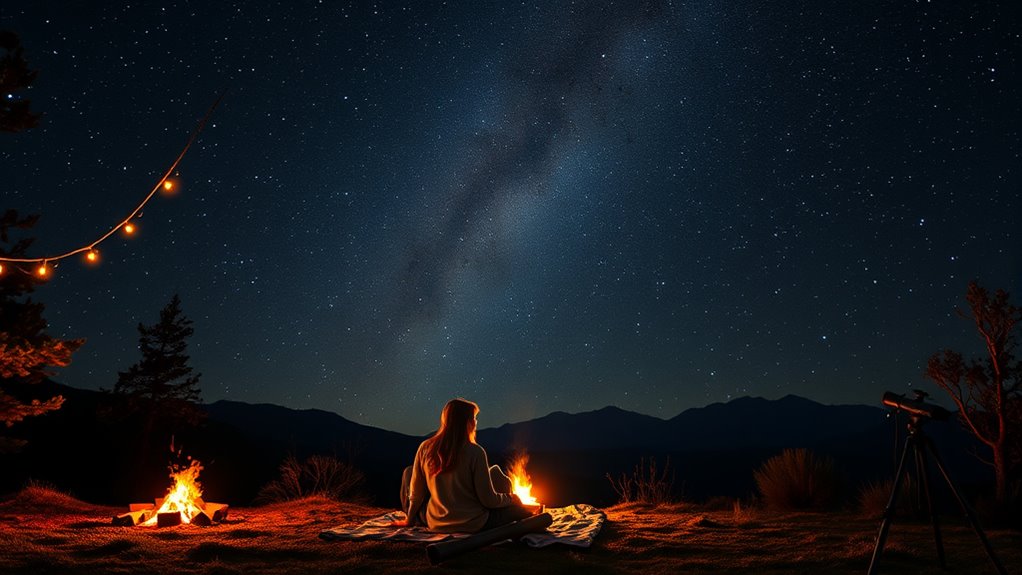For a magical stargazing evening, you can set up a cozy spot away from light pollution, complete with blankets and a telescope. Add themed touches like constellation decorations, snacks, and calming music to enhance the atmosphere. Plan activities such as constellation mapping or watching celestial events like meteor showers. Incorporate ambient lighting and gentle sounds for extra ambiance. Stick around, and you’ll discover even more ideas to make your night unforgettable.
Key Takeaways
- Choose a dark, open location with minimal light pollution for optimal stargazing visibility.
- Create a cozy atmosphere with blankets, soft lighting, snacks, and ambient sound to enhance intimacy.
- Incorporate themed decorations, music, and constellation crafts for a memorable, personalized experience.
- Use astronomy apps or star charts to identify constellations and celestial events like meteor showers or planetary alignments.
- Combine natural sounds, gentle lighting, and shared observations to foster connection and wonder during the night.
Setting Up a Romantic Telescope Viewing Spot
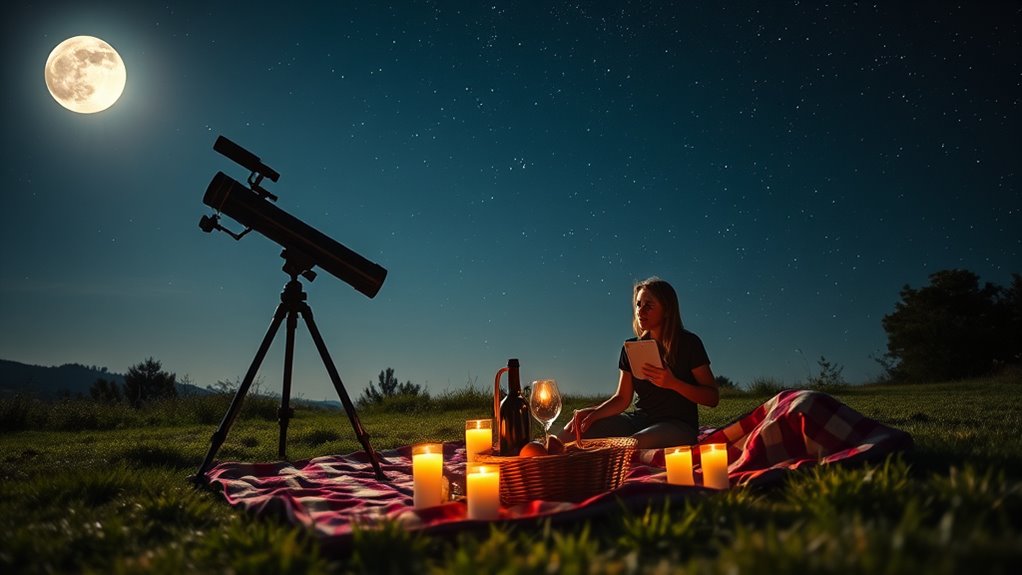
To create a memorable stargazing experience, you need to set up a romantic telescope viewing spot that feels special and comfortable. Find a quiet, open area free of light pollution where you can see the night sky clearly. Bring a blanket or outdoor lounge chairs to make sitting more inviting. Set up your telescope on a stable surface, ensuring it’s easy to access and operate. Add soft lighting, like lanterns or string lights, to create a cozy atmosphere without ruining your night vision. Keep essentials nearby, such as warm drinks, snacks, and a star map or app for spotting constellations. Making the space inviting and relaxed helps you both enjoy the beauty of the stars in comfort and intimacy. Incorporating atmosphere-enhancing elements such as calming lavender oil diffused nearby can further elevate the experience. Additionally, choosing a location with minimal light pollution ensures a clearer view of celestial objects. Ensuring your viewing area is free from wind or disturbances will also help maintain a peaceful environment for your night under the stars. Using a high-quality telescope can significantly improve your viewing experience and reveal more details of celestial bodies.
Creating a Themed Stargazing Picnic
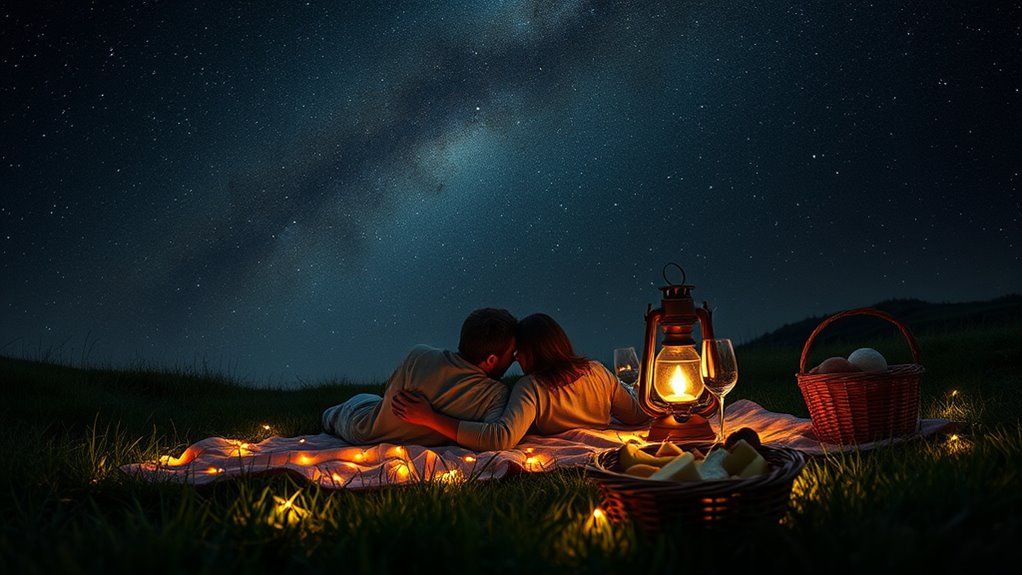
Creating a themed stargazing picnic transforms an ordinary night into a memorable experience by adding a layer of fun and personalization. Start by choosing a theme that resonates with both of you—perhaps a vintage space race, a celestial fairy tale, or a cozy constellation vibe. Decorate your picnic area with themed elements like star-shaped lanterns, glow-in-the-dark stars, or themed tableware. Pack a picnic with foods that match your theme, such as galaxy-inspired desserts or star-shaped snacks. Bring along a cozy blanket, cushions, and portable lights to set a comfortable ambiance. Consider incorporating rustic decor to enhance the cozy, farmhouse-inspired atmosphere. Including a themed playlist can further elevate the mood and create a more immersive experience. Finally, include small themed details, like constellation cards or star maps, to enhance the experience. Themed touches make the evening feel special and more immersive.
Planning a Night of Constellation Mapping
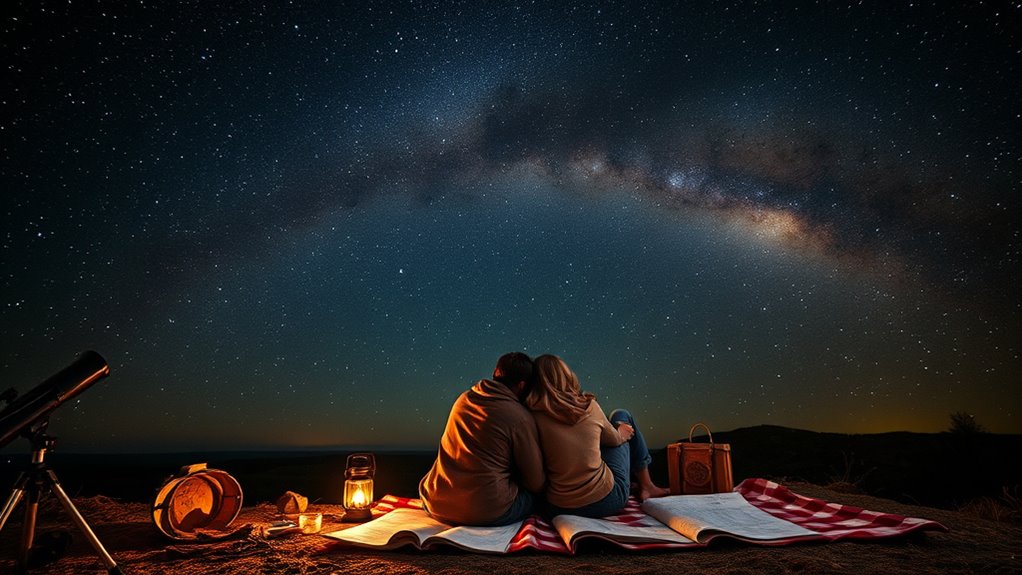
Planning a night of constellation mapping turns your stargazing outing into an interactive adventure. First, choose a clear, dark location away from city lights for ideal visibility. Bring along an astronomy app or a star chart to help identify constellations, and familiarize yourself with their shapes beforehand. Use a flashlight with red light to avoid disrupting night vision. Spread out a blanket or set up reclining chairs to comfortably view the sky. Encourage your partner to participate by identifying specific stars or constellations, making it a collaborative experience. Consider timing your outing around new moon phases for the darkest sky. Being aware of cookie preferences and managing your consent can enhance your online experience when researching stargazing tips or astronomy guides. Incorporating space-saving techniques can help keep your stargazing area organized and clutter-free, making the experience more enjoyable. Understanding payment processing concepts can also assist when booking guided tours or purchasing astronomy equipment online. Additionally, having a basic knowledge of time zones can be useful if coordinating with friends or joining virtual astronomy communities from different regions. Staying informed about emerging AI discoveries can also inspire new ideas for your stargazing adventures. With some preparation, you’ll transform an ordinary night into an engaging and memorable journey through the cosmos.
Hosting a DIY Astronomer’s Workshop
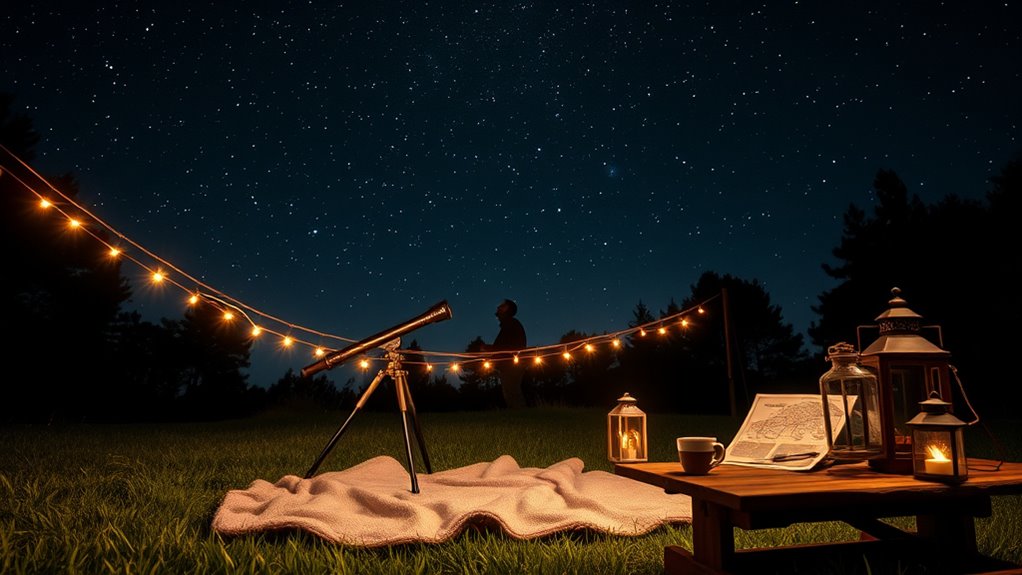
Start by gathering the essential equipment like binoculars, star charts, and a flashlight to guarantee everyone can participate comfortably. Plan activities that are both fun and educational, such as identifying constellations or exploring planet facts. As you host, share your celestial insights to keep the workshop engaging and inspire curiosity in your guests.
Gathering Necessary Equipment
Before hosting your DIY astronomer’s workshop, gather all the essential equipment to guarantee a smooth and engaging experience. Start with binoculars or a beginner’s telescope to give everyone a clear view of the night sky. Bring along a star chart or a stargazing app on your smartphone to help identify constellations and planets. Pack a flashlight with red light to preserve night vision and ensure safe movement in the dark. Don’t forget comfortable blankets or chairs for relaxing while observing. Have some notebooks or printed guides for notes and star maps. Confirm you have batteries, chargers, and any necessary adapters for electronic devices. Double-check your equipment beforehand to avoid surprises. Consider emergency preparedness essentials in case of unexpected situations during your outdoor activity. Additionally, having a basic knowledge of keto diet principles can be helpful if planning a themed outdoor event or snack break. To enhance the experience, you might also include a learning activity that encourages discussion about celestial phenomena. Incorporating basic telescope setup tips can help participants feel more confident when observing. With everything in place, you’ll create an inviting, well-equipped environment for a memorable astronomy adventure.
Planning Engaging Activities
To make your DIY astronomer’s workshop engaging, consider incorporating hands-on activities that encourage participation and curiosity. Start with simple star map crafting, where you and your partner create personalized charts using glow-in-the-dark stickers or markers. This activity sparks conversation and helps you both learn constellation patterns. Next, try assembling a basic telescope or binoculars together, guiding each other through the process, which deepens your understanding of how they work. You can also prepare a selection of celestial images or astronomy videos to examine through your homemade equipment. Encourage questions and discussions about what you’re observing, fostering a sense of discovery. These activities make the evening interactive, fun, and memorable, turning your stargazing into an educational and engaging experience.
Sharing Celestial Insights
Hosting a DIY astronomer’s workshop offers a fantastic opportunity to share your celestial insights and deepen your connection. You can prepare simple activities like identifying constellations or explaining basic astronomy concepts. Bring along star charts, apps, or printed guides to help guide your partner’s discovery. Encourage them to ask questions and share their own observations. Demonstrating how to use a telescope or spotting different celestial objects creates an interactive experience. Keep the atmosphere relaxed and fun, fostering curiosity and shared learning. By sharing your knowledge, you turn a simple night under the stars into a meaningful and memorable bonding moment. This hands-on approach transforms stargazing from passive observation into an engaging exploration of the universe together. Utilizing portable camping gear like telescopes and star charts enhances the experience and makes it more enjoyable.
Incorporating Music and Ambient Lighting for Atmosphere

Creating the right ambiance is essential for a memorable stargazing date, and incorporating music and ambient lighting can considerably enhance the atmosphere. Choose soft, calming tunes that set a relaxing mood without overwhelming the natural sounds of the night. Use portable speakers to play your playlist at a gentle volume, ensuring it complements the quiet of the evening. For lighting, opt for string lights, lanterns, or candles to cast a warm, inviting glow. These subtle light sources add a cozy feel without interfering with the stars. Keep the lighting low and indirect, so it highlights your setup without overpowering the night sky. Incorporating ambient sound design techniques can further deepen the immersive experience and foster a sense of tranquility. Exploring soundscaping options can help create a more dynamic and engaging atmosphere. Additionally, choosing music that inspires self-reflection can enhance the emotional connection during your evening. Incorporating asset division principles, such as balancing the sensory elements, can ensure your environment feels harmonious and well-structured. Together, music and ambient lighting create an enchanting environment that heightens your connection and makes the experience truly magical.
Combining Stargazing With a Nighttime Hike
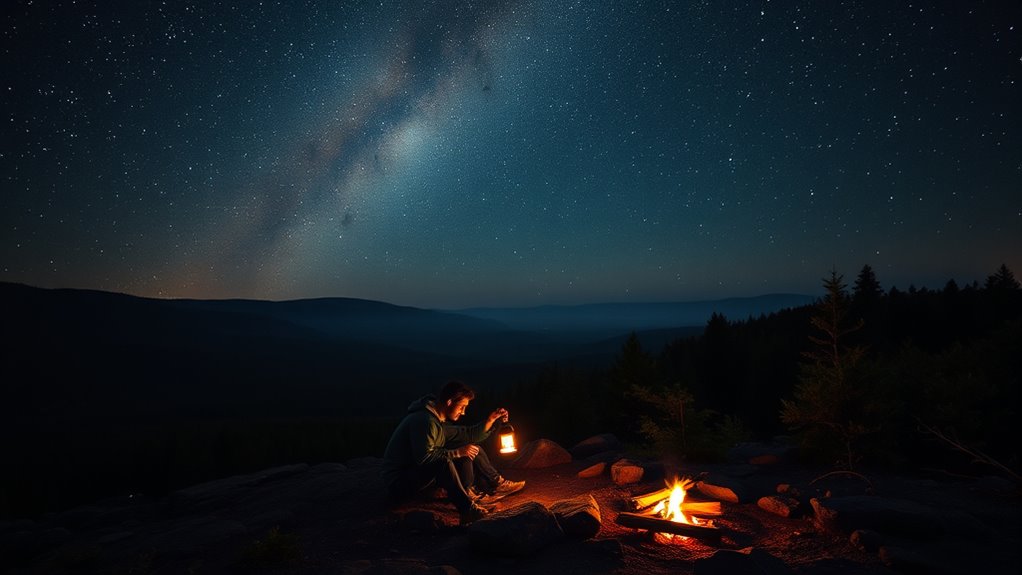
Beginning a nighttime hike before stargazing adds an adventurous element to your date and helps you reach a prime viewing spot away from light pollution. As you navigate the trail, focus on the sounds of nature and the glow of the moon, enhancing the anticipation for stargazing. Choose a route that’s manageable and well-marked, so you can enjoy the hike without stress. Bring a flashlight or headlamp for safety, but keep it dim to preserve night vision. Once you arrive at your vantage point, settle in with blankets and snacks. The hike not only creates shared memories but also elevates the experience, making the stars feel even more magical against the backdrop of nature’s quiet serenity. Additionally, selecting a trail with known weather conditions can help ensure a clear night for optimal stargazing. Incorporating a backcountry site can offer even darker skies and a more immersive experience. Planning your timing carefully can also maximize stargazing opportunities, especially during new moon phases when the sky is darkest, and astronomical events like meteor showers or planetary alignments can enhance the experience. Utilizing star maps or apps can further deepen your understanding and appreciation of the night sky during your outing.
Watching Meteor Showers and Other Celestial Events
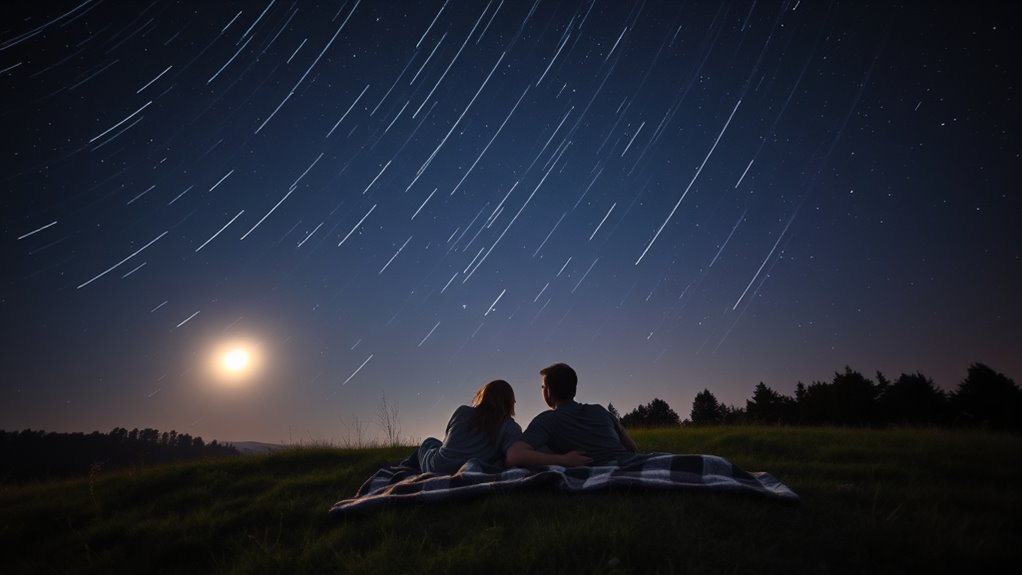
Watching meteor showers and other celestial events can turn a simple night under the stars into an unforgettable experience. Plan your night around peak activity times, and bring blankets, snacks, and a telescope if you have one. Keep your eyes on the sky for shooting stars, planets, or even a lunar eclipse. To enhance your experience, learn about upcoming events so you can anticipate what you’ll see. Here’s a quick guide:
| Event | Best Viewing Time | Tips |
|---|---|---|
| Meteor Shower | Early morning hours | Find dark, open areas |
| Planet Conjunction | Sunset to late night | Use binoculars for detail |
| Lunar Eclipse | Specific date & time | Use a clear sky, bring a camera |
Making a Memory With Star-Themed Crafts and Keepsakes
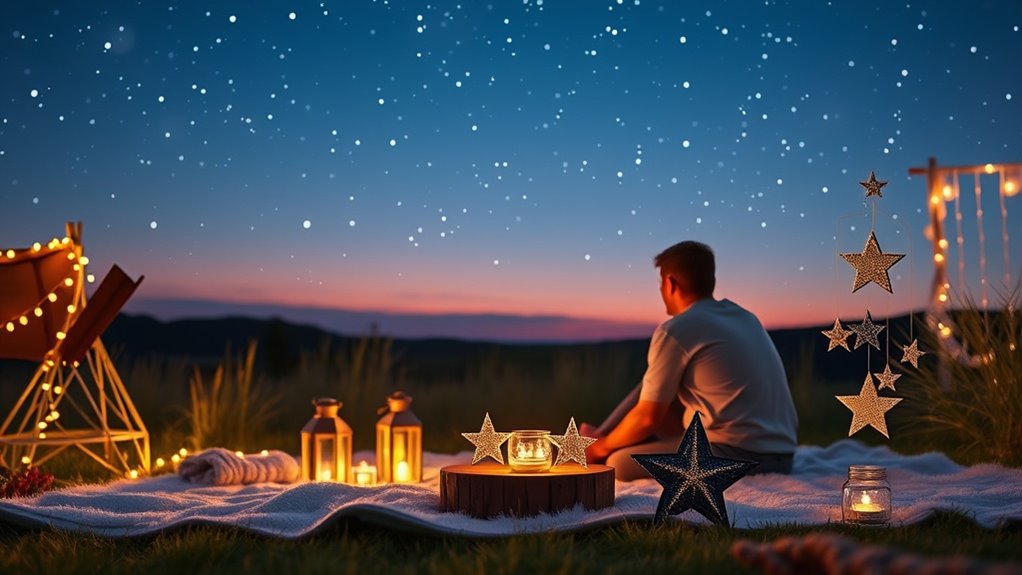
Turning your stargazing night into a lasting memory is easy with star-themed crafts and keepsakes. You can create a personalized constellation jar by filling a glass with tiny glow-in-the-dark stars or paint your own starry night on a canvas. Consider making a star-shaped photo frame to hold a special picture from the evening, capturing the moment forever. Crafting a star mobile or string lights adds a whimsical touch to your space, reminding you of the night’s magic. You might also write down your favorite celestial memories or dreams on star-shaped notes and keep them in a keepsake box. These creative projects not only preserve your experience but also make meaningful mementos you can cherish for years to come.
Frequently Asked Questions
What Are the Best Months for Optimal Stargazing Conditions?
You’ll want to plan your stargazing during the months when the nights are longest and skies are clearest. Typically, late fall through winter—October to February—offer the best conditions, especially in colder regions where the air is crisp and dry. Avoid full moons, as their brightness can wash out stars. Check local weather and moon phases to maximize your chances of enjoying a clear, star-filled night.
How Can I Identify Different Constellations Easily?
To identify constellations easily, start by using a star chart or a stargazing app; these tools highlight prominent patterns in the night sky. Look for bright stars and unique shapes that stand out. Practice regularly, and note the positions of constellations relative to the seasons. With patience and some guidance, you’ll quickly learn to spot different patterns and become more confident in your stargazing adventures.
What Safety Precautions Should I Take During Nighttime Activities?
Think of nighttime safety like steering through a starry sky—being prepared keeps you on course. Always carry a flashlight, wear reflective clothing, and stay in well-lit areas to avoid hazards. Let someone know your plans, and avoid risky terrains or unfamiliar places. Trust your instincts; if something feels off, it’s okay to head back. Staying vigilant guarantees your evening remains magical, not marred by avoidable mishaps.
Are There Any Apps Recommended for Stargazing Assistance?
You should definitely try some stargazing apps to enhance your experience. Apps like SkyView, Star Walk, and Stellarium are highly recommended because they help you identify stars, planets, and constellations easily. Simply point your phone at the sky, and these apps will do the rest. They’re user-friendly and perfect for beginners or seasoned stargazers alike. Download one before your night out, and you’ll enjoy a more immersive and educational experience.
How Can I Customize My Stargazing Experience for Special Occasions?
You can create a memorable night by customizing your stargazing experience for special occasions. Focus on the details: choose a meaningful location, plan a personalized playlist, and prepare favorite snacks. Enhance the atmosphere with cozy blankets, fairy lights, or candles. Engage your senses by sharing stories or wishes under the stars. By tailoring each element, you turn a simple sky-watching session into a heartfelt celebration of your unique bond.
Conclusion
No matter which stargazing idea you choose, you’re creating a night where memories sparkle brighter than the stars themselves. It’s an evening to lose yourself in wonder, feeling the universe’s magic wrap around you like a warm blanket. So, gather your loved ones, breathe in the night air, and let the cosmos be your backdrop for a truly enchanting experience—because some moments are written in the stars, forever etched in your heart.
